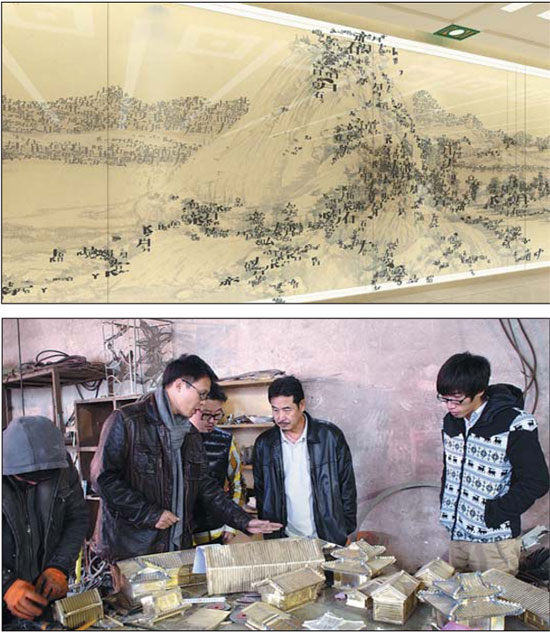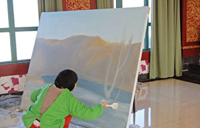
 'Taken 2' grabs movie box office crown
'Taken 2' grabs movie box office crown
 Rihanna's 'Diamonds' tops UK pop chart
Rihanna's 'Diamonds' tops UK pop chart
 Fans get look at vintage Rolling Stones
Fans get look at vintage Rolling Stones
 Celebrities attend Power of Women event
Celebrities attend Power of Women event
 Ang Lee breaks 'every rule' to make unlikely new Life of Pi film
Ang Lee breaks 'every rule' to make unlikely new Life of Pi film
 Rihanna almost thrown out of nightclub
Rihanna almost thrown out of nightclub
 'Dark Knight' wins weekend box office
'Dark Knight' wins weekend box office
 'Total Recall' stars gather in Beverly Hills
'Total Recall' stars gather in Beverly Hills
Underground art, literally
Updated: 2013-03-21 09:46
By Wang Kaihao (China Daily)
|
||||||||
 |
|
From top: Design sketch of the replica of Dwelling in the Fuchun Mountains for the National Art Museum of China Station. Wang Zhong (second from right) and his colleagues work on the subway project. Photos Provided to China Daily |
For example, Line 8 along Beijing's central axis is called "mark of an ancient capital", while Line 10, passing Beijing's major business and recreation areas, is themed "colorful new life".
Wang says a lot of thought went into design for the National Art Museum of China Station. Team member Ma Juncheng came up with the idea of using character radicals to create a replica of Dwelling in the Fuchun Mountains, by Yuan Dynasty painter Huang Gongwang (1269-1354).
|
|
| Artists in tune with global audiences |
|
|
| Accidental artists |
"Chinese characters have been passed on for thousands of years," Ma explains. "They represent our culture, which is also famed for its continuity."
Painters once drew frescos at stations along Line 2 in the 1980s to introduce the capital's history, but they generally mimic Soviet-style works in Moscow's subway.
"Those works are of a very high standard as single works, but many are easily overlooked because of poor lighting conditions," Wang explains. "You cannot expect passengers in a hurry to stare at these great works and admire this city's panoramic epic with just a glance."
A similar type of work has been unveiled on Line 6: a series of frescos to reflect Beijing's landscapes.
A 100-square-meter fresco at Beihai North Station portraying Beihai Park in Spring has attracted considerable media attention. It took one year for Sun Tao from the China Mural Association to use 50 kinds of stones from more than 10 countries to create the giant work.
Even so, Wang wants more diversity.
"Art has been used as supplemental decoration, but now it should make the whole space more dynamic."
Most Viewed
Editor's Picks

|

|

|

|

|

|
Today's Top News
Boston bombing suspect reported cornered on boat
7.0-magnitude quake hits Sichuan
Cross-talk artist helps to spread the word
'Green' awareness levels drop in Beijing
Palace Museum spruces up
First couple on Time's list of most influential
H7N9 flu transmission studied
Trading channels 'need to broaden'
US Weekly

|

|










